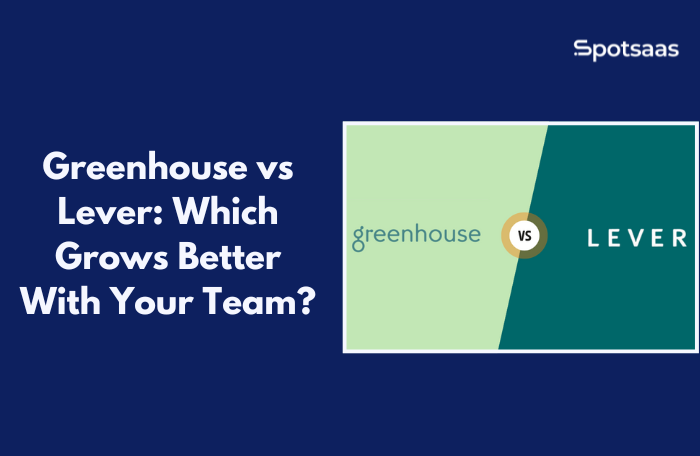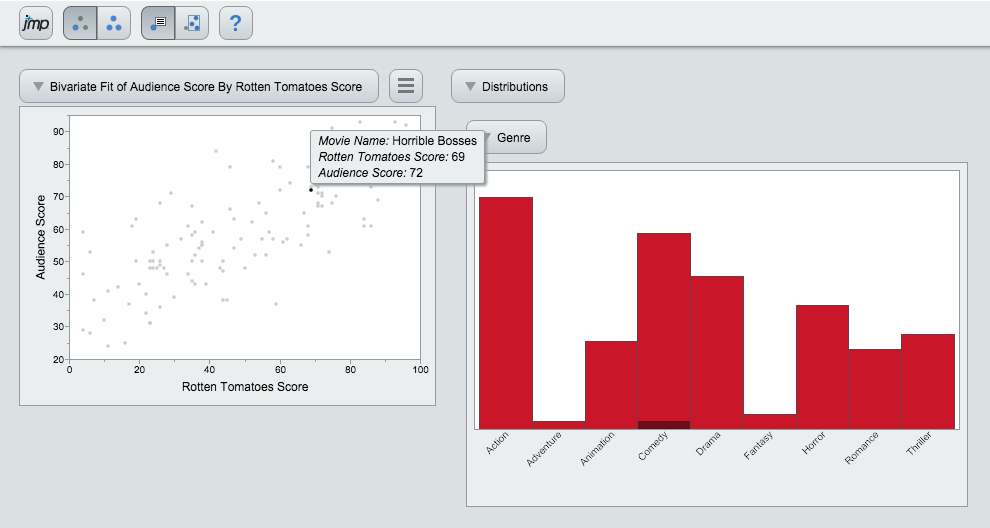Hiring moves fast, and without the right tools, great candidates can slip through the cracks. That’s why many teams turn to an applicant tracking system (ATS) to manage their recruitment process more efficiently. An ATS helps organize job postings, track applicants, streamline interviews, and improve collaboration across hiring teams.
Two names that often come up in this space are Greenhouse and Lever. Both platforms offer modern solutions built to support companies of all sizes—but each brings a slightly different approach to hiring.
If you’re exploring which platform aligns better with your team’s needs, this side-by-side comparison covers everything from core features and user experience to pricing and support—so you can make an informed decision with confidence.
Greenhouse vs Lever: Quick Comparison Table
| Feature | Greenhouse | Lever |
|---|---|---|
| Pricing | Custom pricing (based on company size) | Custom pricing (based on features & size) |
| Integrations | ✅ 300+ integrations | ✅ 250+ integrations |
| Ease of Use | ✅ Structured workflows | ✅ Clean interface, fast navigation |
| Scalability | ✅ Enterprise-ready | ✅ Great for scaling teams |
| Support | ✅ Email, live chat, knowledge base | ✅ Dedicated CSM (higher plans) |
| Best For | Mid-size to enterprise teams | Startups to mid-size teams |
Greenhouse vs Lever: ATS Overview
Greenhouse: Structured Hiring at Scale
Greenhouse is a leading applicant tracking system designed to help companies build scalable and consistent hiring processes. It centralizes everything from job postings to candidate evaluation, enabling teams to collaborate more effectively throughout the hiring cycle.
With a focus on structured interviews and data-backed hiring, Greenhouse empowers teams to make confident decisions. Its flexible workflows and wide integration options make it a strong fit for growing organizations aiming to standardize recruitment.
| Greenhouse Overview | |
|---|---|
| Used By | Thousands of organizations globally, including brands like HubSpot, Stripe, and DoorDash |
| Focus Areas | Structured hiring, interview planning, diversity hiring, advanced reporting |
| Typical Users | Mid-sized to large businesses with dedicated talent teams |
| Best Known For |
|
Lever: ATS + CRM for Proactive Hiring
Lever is an all-in-one talent acquisition platform that blends the power of an ATS with built-in candidate relationship management (CRM). It’s designed to help companies not just manage applicants, but also source, nurture, and re-engage top talent over time.
Lever offers a collaborative interface that makes it easy for recruiters and hiring managers to stay aligned. With a strong emphasis on automation and candidate experience, Lever is ideal for forward-thinking hiring teams.
| Lever Overview | |
|---|---|
| Used By | 5,000+ companies across tech, finance, healthcare, and more |
| Focus Areas | Pipeline building, candidate engagement, automation, recruiting analytics |
| Typical Users | Startups and mid-sized teams looking to scale hiring without losing the personal touch |
| Best Known For |
|
Key Features Comparison: Greenhouse vs Lever
Choosing the right applicant tracking system isn’t just about ticking off feature boxes. It’s about finding a platform that fits how your team hires. Here’s a deeper look at how Greenhouse and Lever handle five essential functions every growing company needs in their hiring toolkit:
| Feature | Greenhouse | Lever |
|---|---|---|
| Job Posting | Multi-board posting, branded pages, source tracking | Job board integrations, customizable templates |
| Pipeline Management | Structured workflows with hiring stages | Drag-and-drop pipeline with CRM-style views |
| Interview Scheduling | Calendar sync, scorecards, interview kits | Built-in collaboration tools and real-time scheduling |
| Reporting | Advanced dashboards for DEI, funnel, time-to-hire | Visual reports with role, recruiter, and source filters |
| CRM Features | Limited CRM, mainly ATS-focused | Built-in CRM for sourcing and nurturing candidates |
Job Posting & Distribution
- Greenhouse makes it simple to post jobs across hundreds of boards, including LinkedIn, Indeed, and Glassdoor—all from one place. You can set up branded career pages, customize listings per location or department, and even automate publishing based on roles. This helps teams maintain consistency and saves time during hiring surges.
- Lever also offers broad distribution through native job board integrations, with added flexibility in customizing the look and feel of job posts. Teams can use Lever’s built-in templates or connect their postings to a branded careers site. While both platforms support multi-channel publishing, Greenhouse stands out with more advanced customization options.
Candidate Pipeline Management
- Greenhouse is known for its structured approach. Every candidate moves through predefined hiring stages—each with specific actions, approvals, and documentation. This makes it easier for recruiters and hiring managers to stay aligned and ensure that no one falls through the cracks.
- Lever, in contrast, offers a more flexible pipeline with drag-and-drop functionality. It’s ideal for teams who want to visualize candidate movement in real-time, similar to a CRM. Lever’s interface also surfaces previous touchpoints so teams can quickly reference past conversations or interview notes.
Interview Scheduling & Collaboration
- Greenhouse offers deep integrations with both Google Workspace and Microsoft 365, making it easy to align interviewer availability and send out invites. Each interview can be paired with a guide or scorecard, helping teams stay consistent and objective in evaluations.
- Lever goes a step further with built-in collaboration tools. Team members can tag each other with @mentions, leave private or shared notes, and automate reminders for interviewers. This is especially useful in fast-paced environments where multiple team members are involved in the process.
Reporting & Analytics
- Greenhouse offers powerful analytics across the entire hiring funnel. You can track metrics like time-to-fill, pass-through rates, source quality, and diversity performance. For companies hiring at scale, these insights are invaluable in refining recruiting strategies and improving outcomes.
- Lever provides visual dashboards and ready-to-use reports that are easy to understand—even for non-technical users. Teams can filter data by job, recruiter, or location, helping them identify trends and hiring bottlenecks without needing external tools.
CRM Capabilities
- Greenhouse functions primarily as an ATS. While it can integrate with third-party CRM tools, its native candidate-nurturing features are limited. It’s a great fit for teams focused on structured hiring but less so for long-term relationship-building with passive talent.
- Lever was designed with CRM at its core. It allows teams to build talent pipelines, tag passive candidates, track outreach history, and even email nurture campaigns. This makes Lever a better option for companies that want to engage talent before they apply rather than only when a position opens.
Greenhouse vs Lever: User Experience & Interface
A powerful applicant tracking system is only valuable if your team enjoys using it. Here’s how Greenhouse and Lever compare in terms of design, ease of navigation, and day-to-day user experience.
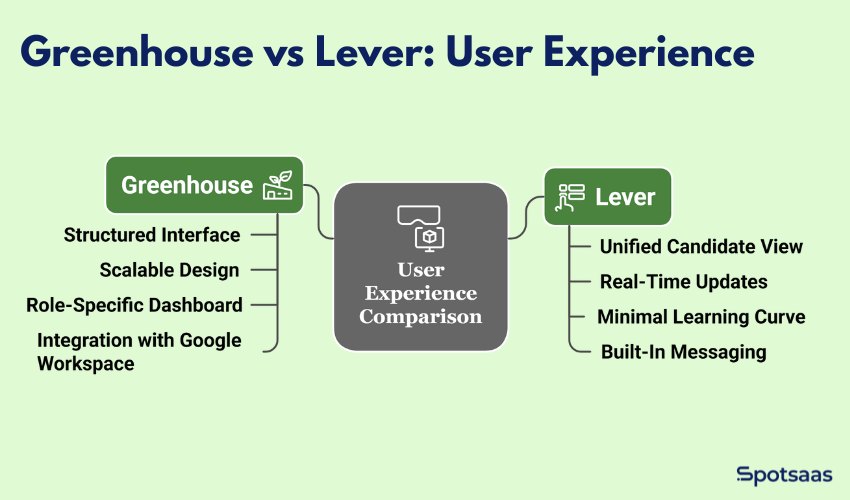
Greenhouse: Structured, Professional, and Scalable
Greenhouse offers a clean, intuitive interface that prioritizes structure. Every feature is organized around workflows, making it easy for recruiting teams to follow consistent processes. The layout is clear and task-driven, which helps larger teams manage roles, permissions, and collaboration efficiently. While there may be a slight learning curve during onboarding, teams quickly adapt once workflows are in place.
- Dashboard designed for role-specific tasks
- Easy-to-navigate menus and workflows
- Strong admin controls for large teams
- Seamless integration with Google Workspace and Outlook
Lever: Flexible, Visual, and Fast to Adopt
Lever’s interface stands out for its simplicity and speed. It combines applicant tracking with CRM functionality, so users can access candidate history, communication, and status updates—all in one view. The drag-and-drop pipeline and Gmail-style layout make it easy for recruiters to engage with candidates and collaborate with hiring managers.
- Unified view of candidate journey
- Real-time updates and quick actions
- Minimal learning curve for new users
- Built-in messaging, tagging, and reminders
Summary:
Greenhouse is ideal for teams that thrive on structure and standardized processes, especially in complex or high-volume hiring. Lever is better suited for teams that prefer a lighter, more visual workflow with built-in collaboration and candidate engagement tools.
Greenhouse vs Lever: Pricing Breakdown
Both Greenhouse and Lever offer flexible pricing models tailored to the size and needs of your organization. While exact pricing isn’t publicly listed, here’s what you should know before reaching out for a quote:
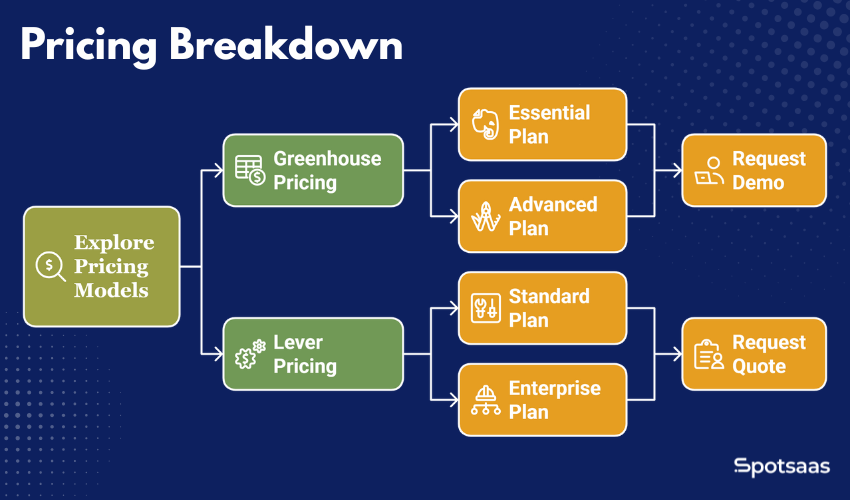
Greenhouse
Greenhouse offers tiered pricing plans to accommodate businesses of varying sizes and growth stages. While specific pricing details are not publicly disclosed, the available plans include:
- Essential: Designed to help organizations build, streamline, and manage a structured hiring process while enhancing the candidate experience.
- Advanced: Includes all features of the Essential plan, with additional tools to configure, scale, and automate recruiting processes as your organization grows.
To obtain detailed pricing information and determine the best fit for your company’s needs, it’s recommended to request a demo through Greenhouse’s official website.
Lever
Lever pricing offers customizable plans tailored to organizations of various sizes and hiring needs. While specific pricing details are not publicly disclosed, Lever provides two primary packages:
- Lever: This plan includes core features such as Applicant Tracking, Candidate Relationship Management, a vast integration ecosystem, Reporting, Analytics & Visual Insights, DEI solutions, and Global Compliance (GDPR).
- Lever for Enterprise: In addition to the features offered in the standard Lever package, this plan includes Advanced Automation, Offer and Requisition Management, Premium Integrations, Data Explorer, Premium Sourcing, and Candidate Experience Surveys.
Both plans allow for further customization with add-ons like Advanced Nurture, Advanced Analytics, Candidate Texting, and Career Site Builder. Some integrations and advanced features may incur additional fees, enabling you to select options that align with your hiring objectives.
To obtain a personalized quote and determine the best fit for your company’s requirements, it’s recommended to request a demo through Lever’s official website.
Greenhouse vs Lever: Pros and Cons
| Platform | Pros | Cons |
|---|---|---|
| Greenhouse |
– Structured hiring workflows – Advanced reporting tools – DEI-focused features – 300+ integrations – Enterprise-level scalability |
– Weak CRM tools – Learning curve – No public pricing |
| Lever |
– ATS + CRM unified – Easy to use – Talent rediscovery tools – Visual drag-and-drop – Ideal for startups |
– Lacks structure for enterprise – Premium features cost more – Limited admin controls |
Greenhouse
Pros
- Structured workflows support consistent hiring – Greenhouse offers a highly organized approach to recruitment. Its structured workflows ensure every candidate goes through the same standardized process, which helps reduce bias and maintain fairness across all roles.
- Powerful reporting and analytics – The platform gives recruiters access to detailed reports and customizable dashboards. Whether it’s tracking time-to-hire, source effectiveness, or pipeline health, Greenhouse makes it easy to understand what’s working and what’s not.
- DEI-friendly screening tools – Greenhouse takes diversity seriously, with features like anonymized applications and scorecards that help reduce unconscious bias. These tools give teams a practical way to build more inclusive hiring processes.
- Extensive integration ecosystem – With 300+ integrations, including Slack, LinkedIn, Zoom, and assessment platforms, Greenhouse fits easily into most HR tech stacks. You don’t have to rebuild your process from scratch—just plug and play.
- Trusted by high-growth companies – Greenhouse is a go-to solution for large or fast-growing businesses. Its scalability and reliability make it a strong choice for companies managing multiple roles across departments or regions.
Cons
- Limited CRM capabilities without add-ons – While it excels at structured hiring, Greenhouse doesn’t offer built-in CRM features unless you connect it with a third-party tool. This limits its usefulness for teams focused on long-term candidate relationship management.
- Takes time to learn – The platform’s rich feature set can be a double-edged sword. New users may face a learning curve during the initial setup and configuration phase.
- Pricing isn’t transparent – Greenhouse does not list pricing publicly—you’ll need to contact their team for a custom quote. This can make it hard to compare upfront with other options.
Lever
Pros
- All-in-one ATS + CRM – Lever combines applicant tracking with CRM functionality in a single platform. This makes it easy to manage active hiring while also maintaining relationships with passive candidates.
- User-friendly interface – The platform’s clean, modern layout is easy to navigate, even for new team members. Setup is fast, and teams can start hiring without much training or IT support.
- Strong candidate nurturing – With tools like automated follow-ups, talent rediscovery, and smart filters, Lever helps recruiters reconnect with past applicants and build pipelines for future roles.
- Visual pipelines and drag-and-drop stages – Its workflow is built around visual stages, so recruiters can simply drag candidates from one phase to another, making it easy to track progress at a glance.
- Ideal for startups and fast-paced teams – Lever’s flexibility and speed make it a strong fit for startups or agile hiring teams that need to move quickly without getting bogged down by process.
Cons
- Too flexible for highly structured hiring – For companies that rely on strict processes and documentation, Lever’s open-ended setup might feel too loose or inconsistent.
- Advanced features cost more – Some of the more powerful tools—like advanced analytics and integrations—are only available in higher-tier plans, which can stretch budgets for smaller teams.
- Fewer controls for large orgs – Lever lacks some of the enterprise-level admin features and permission settings that larger companies may require for compliance and governance.
- Basic career site customization – Although it supports branded career pages, the level of design customization is limited compared to more design-centric platforms.
Greenhouse vs Lever: Customer Support & Onboarding
A smooth onboarding process and reliable customer support can make all the difference, especially when introducing a new hiring platform to your team. Here’s how Greenhouse and Lever compare:
Greenhouse
Greenhouse offers a structured onboarding process that includes dedicated implementation support, training sessions, and access to a comprehensive knowledge base. Most plans also include a customer success manager to help you stay on track post-launch.
Their support team is responsive and well-reviewed, especially for enterprise customers.
- Dedicated onboarding specialists for new customers
- Step-by-step setup guidance and custom workflows
- Live chat, email, and help center resources
- Customer success support is available on most plans
Lever
Lever is known for quick implementation, especially for small and mid-sized teams. New customers get a guided setup experience, access to training resources, and responsive support. For larger teams or those using Lever’s full suite, dedicated success managers and strategy sessions are available.
- Fast implementation for most use cases
- Knowledge base, help center, and training webinars
- Priority support for enterprise accounts
- Onboarding tailored by plan level and features selected
Summary:
Greenhouse offers a more hands-on onboarding experience that is ideal for larger teams and complex workflows. Lever provides a faster, streamlined setup that appeals to startups and agile hiring teams.
Greenhouse vs Lever: Which Platform Fits Your Hiring Style?
Both Greenhouse and Lever offer powerful recruiting solutions, but they’re built with slightly different priorities in mind. Here’s a quick breakdown to help you match the right platform to your team’s needs:
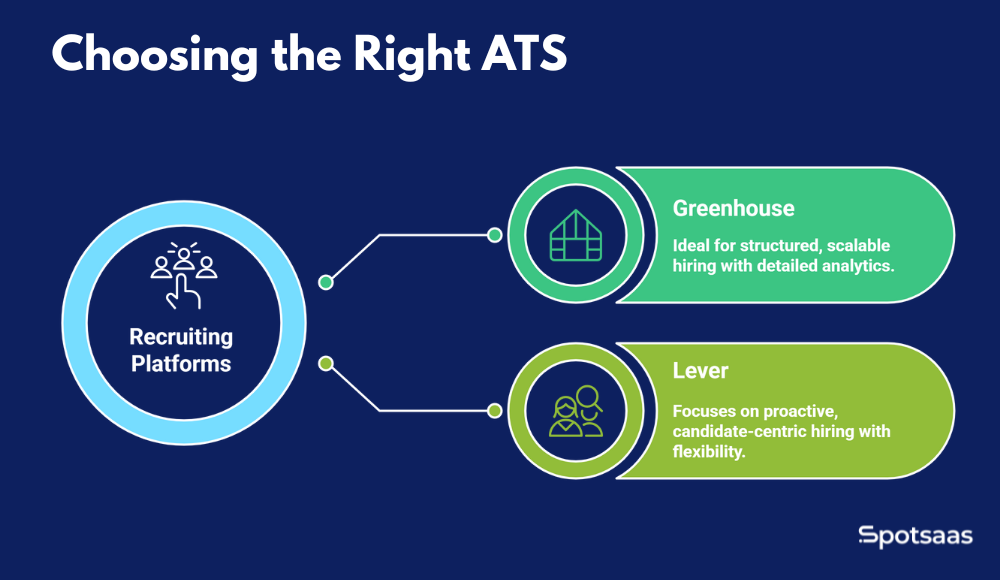
Greenhouse: Best for Structured, Scalable Hiring
Greenhouse is ideal for organizations that value consistency, structure, and detailed hiring analytics. Its workflow-driven approach works especially well for teams with defined hiring processes and multiple stakeholders involved. If your company is scaling fast, hiring across departments, or investing in DEI programs, Greenhouse offers the tools to support that growth.
Best fit for:
- Mid-size to enterprise-level teams
- Companies focused on structured hiring and collaboration
- Organizations prioritizing DEI and compliance
- Teams that need detailed reporting and workflow control
Lever: Best for Proactive, Candidate-Centric Hiring
Lever is built for teams that want speed, flexibility, and a strong focus on candidate experience. Its unified ATS + CRM setup makes it easy to track talent across multiple hiring cycles, nurture relationships, and re-engage passive candidates. Lever works well for companies that move fast and want to keep a personal touch in their hiring process.
Best fit for:
- Startups and growing companies
- Teams that source proactively and build talent pipelines
- Recruiters who value simplicity and automation
- Companies focused on candidate engagement and internal collaboration
Alternatives to Greenhouse and Lever
While Greenhouse and Lever are both excellent platforms, they may not be the perfect fit for every team. If you’re looking for something with different features, pricing, or complexity, here are a few strong alternatives to consider:
| Tool | Best For | Top Features |
|---|---|---|
| Workable | Essential hiring tools with minimal setup |
• Job board posting • AI sourcing • Video interviews |
| JazzHR | Budget-conscious teams |
• Custom workflows • Flat-rate pricing • Offer tracking |
| Ashby | Tech-driven, fast-scaling teams |
• DEI reports • Scheduling tools • Chrome extension |
| Breezy HR | Collaborative, remote-friendly teams |
• Kanban-style UI • SMS/email tools • Referral tracking |
Greenhouse vs Lever: Cost Summary & What to Expect
Both Greenhouse and Lever follow a custom pricing model, which means costs are based on factors like company size, number of hires, and features required. While pricing details aren’t public, here’s a general overview of what influences the investment:
Greenhouse
Greenhouse pricing is typically structured in three tiers: Essential, Advanced, and Expert. The cost increases based on feature access, integrations, and support level. It’s generally considered a mid to high-tier investment, especially for teams managing multiple roles or locations.
What affects the price:
- Number of employees or active jobs
- Required integrations and automation
- Implementation complexity
- Support and reporting needs
Lever
Lever also offers tiered plans, including options for core ATS features (Lever Hire) and advanced capabilities like analytics (Lever Analytics) or CRM (Lever Nurture). It’s often more flexible for smaller teams, and pricing scales as more modules are added.
What affects the price:
- Plan selection (Hire, Nurture, Analytics, or full suite)
- Team size and roles
- Need for CRM, texting, or reporting add-ons
- Implementation and training services
Conclusion
Greenhouse and Lever stand out as two of the most trusted applicant tracking systems available today. While both platforms aim to streamline hiring, their strengths serve different team dynamics.
Greenhouse supports structured, data-driven hiring at scale—ideal for teams looking for standardization, DEI tools, and detailed reporting. Lever focuses on speed, flexibility, and long-term candidate engagement, making it a great fit for agile, growing companies.
Understanding your hiring priorities is the key to making the right choice. Whether you need a workflow-powered system or a candidate-focused CRM experience, both platforms offer the capabilities to support efficient, high-quality recruitment.
Frequently Asked Questions
Is Greenhouse or Lever better for large teams?
Greenhouse is better suited for large teams due to its structured workflows and enterprise-level features.
Does Lever include built-in CRM features?
Yes, Lever combines ATS and CRM functionality in one platform.
Can Greenhouse integrate with HR tools like Slack or LinkedIn?
Yes, Greenhouse offers 300+ integrations, including Slack, LinkedIn, and HRIS platforms.
Which tool is easier to set up for startups?
Lever is generally easier to implement and adopt for small and mid-sized teams.
Does either platform offer a free trial?
No, both Greenhouse and Lever offer personalized demos instead of free trials.
Which platform is better for candidate nurturing?
Lever is the better option for nurturing candidates with built-in engagement tools.


